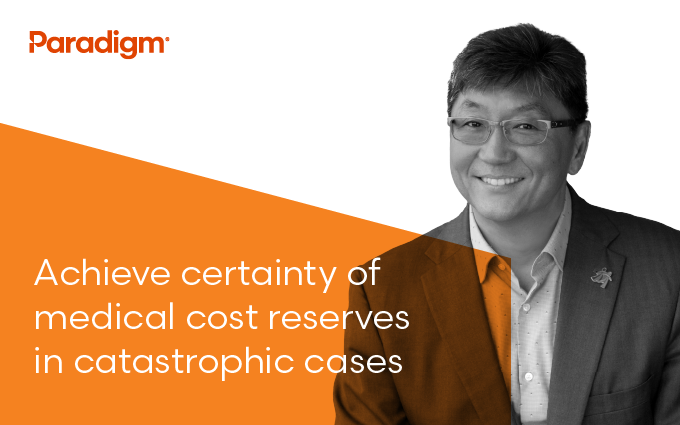07/31/2023

Life expectancy calculation has long played an important role in both workers’ compensation claims management and the broader insurance industry. This is particularly true for catastrophic injuries. Any payer responsible for taking care of a patient or injured worker with a serious diagnosis must accurately reserve for future costs anticipated over the remaining life of the claim.
Additionally, from a clinical standpoint, accurate life expectancy calculation enables claims professionals to better anticipate different care needs, depending on the age of each injured worker and the remaining life expectancy. Someone with a life expectancy of 40 more years will not have the same care and treatment configuration as a patient with a much shorter life expectancy.
When it comes to catastrophic injuries, the severity and uncertainty of the given conditions make calculating life expectancy and setting medical reserves even more complex. Across the workers’ compensation industry, this process has been inconsistent and remains labor intensive for catastrophic workplace injuries.
To provide more consistent estimates of medical cost reserves in catastrophic cases, the clinical and analytics teams at Paradigm have worked in close collaboration to develop a standardized Lifetime Expectancy Calculator using an evidence-based, clinically verified methodology. The application of this proprietary tool is specific and exclusive to our Hero CatastrophicSM Outcome Plans.
Catastrophic injury care and life expectancy calculation
A strong example of the complexity involved in estimating life expectancy after a catastrophic injury would be for a patient with a spinal cord injury. Traditionally, to estimate life expectancy, one would utilize the mortality data from the Centers for Disease Control and Prevention (CDC) or refer to injury-specific sources, such as the National Spinal Cord Injury Model Systems Database, as resources. What’s more confounding is how to properly account for and balance various factors, such as age, gender, ethnicity, and injury-related impairments, with other medical comorbidities and lifestyle factors associated with the individual. These challenges have led to the long-held view that life expectancy calculation is more of an art than a science—from both an insurance and clinical standpoint.
The lack of a standardized, evidence-based methodology has led to wide variation and uncertainty among both claims professionals and clinicians when it comes to calculating life expectancy, particularly for catastrophic injuries. In many situations, a payer or injured worker could hypothetically arrive at multiple different figures from different physicians or adjusters—and none with a high degree of confidence in their accuracy. The clinical and analytics teams at Paradigm saw this as a significant opportunity to increase certainty and consistency for clients.
Designing the Paradigm Lifetime Expectancy Calculator
Recognizing the importance of accurate lifetime expectancy measurement to claims professionals, we saw a critical need to streamline and improve this process by developing a standardized approach to calculating life expectancy for our HERO Catastrophic Outcome Plans. The result is Paradigm’s proprietary Lifetime Expectancy Calculator tool.
In designing this calculator, Paradigm was committed to achieving three primary objectives:
With the above objectives in mind, we leveraged our wealth of our collective clinical expertise, data, and experience from more than 30 years of managing catastrophic conditions in the workers’ compensation industry to create a consistent and more certain approach to calculating a “rated age” of any injured worker.
Paradigm’s clinical and analytics teams performed extensive research into the specific effects of these injuries on life expectancy to assimilate this data into a workable application.
Impact of catastrophic injuries, comorbidities, and lifestyles
The rated age and resulting life expectancy are based on health factors that can make a patient functionally older or younger than their physiological calendar age. Comorbidities and chronic conditions—such as diabetes, cardiovascular problems, cancer, kidney problems, and immunological issues—influence the rated age. To be appropriate and accurate, our algorithm was designed to give “credits” as well as “debits” to one’s rated age, based upon positive or negative lifestyle factors. For example, a healthy lifestyle or behavior would benefit an age rating, while certain chronic medical conditions would detract from the rating.
The Lifetime Expectancy Calculator has been evaluated by Paradigm Medical Directors using data from their catastrophic injury cases. It has also been independently verified by an external, highly reputable actuarial company for alignment and accuracy. This helps to ensure that the assumptions we are putting into our data analyses and calculations align with the real-world experience of clinicians as well as national actuaries in the field.
Carefully calibrated for catastrophic cases
As the industry benchmark for guaranteed, proven outcomes that genuinely change the lives of people facing the most serious workplace injuries, Paradigm is committed to measuring and articulating metrics for the highest levels of service and quality assurance. Specifically designed for the needs of catastrophic injuries and available exclusively with HERO Catastrophic Outcome Plans, the Lifetime Expectancy Calculator represents one more way Paradigm helps our partners optimize planning to achieve better outcomes for the injured workers we mutually serve.
Learn about HERO Catastrophic and how we deliver certainty for medical costs and injured worker outcomes.